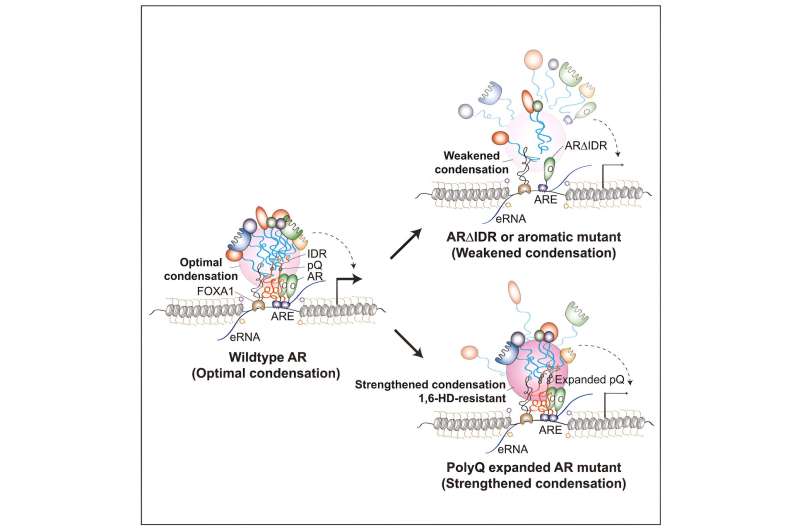This article has been reviewed according to Science X's editorial process and policies. Editors have highlighted the following attributes while ensuring the content's credibility:
fact-checked
peer-reviewed publication
trusted source
proofread
Research finds that targeting certain molecular interactions could yield new strategies for treating prostate cancer

Research led by Mays Cancer Center at The University of Texas Health Science Center at San Antonio (UT Health San Antonio) has discovered that altering certain molecular interactions could yield new strategies for treating prostate cancer and related diseases.
The study focuses on androgen receptors (AR), which are protein molecules that help direct the development of male sexual characteristics, essentially by turning genes on or off as necessary.
The researchers determined that an optimum level of androgen receptor "multivalent interactions" likely is required for proper function. Multivalent interactions involve a simultaneous binding of multiple molecules on the same regulatory chromatin sites to control gene expression. (Chromatin refers to a mixture of DNA and proteins that form the chromosomes found in cells.) The scientists also concluded that alterations of these interactions might underlie the cause and development of disease.
"Our results provide molecular insights for potential therapeutic strategies to treat prostate cancer and other AR-involved diseases by targeting AR multivalent interactions," said Zhijie "Jason" Liu, Ph.D., associate professor and CPRIT Scholar in Cancer Research with Mays Cancer Center and the Institute of Biotechnology of the Department of Molecular Medicine at UT Health San Antonio.
He is lead author of the article titled, "Hormone-induced enhancer assembly requires an optimal level of hormone receptor multivalent interactions," published Sept. 21 in Molecular Cell. Other researchers are from the Sam and Ann Barshop Institute for Longevity and Aging Studies at UT Health San Antonio; the California Institute of Technology; and the Duke Cancer Institute at Duke University.
They observed that androgen receptors form local high-concentration "condensates"—membrane-less subunits that carry out specialized cell functions—through protein-clustering interactions. These are driven by certain multivalent interactions in response to androgen hormone stimulation.
The researchers determined that disturbing those condensates impairs androgen receptor function in the assembly of "enhancers," referring to DNA sequences that activate transcription independently.
"Our work using AR as an example provides evidence for the importance of maintaining precise levels of multivalent interactions to achieve beneficial hormone-induced enhancer assembly events," Liu said. "Collectively, our results suggest that disruption of the fine-tuned AR protein multivalent interactions might underlie AR-related human pathologies.
"AR multivalent interactions," he concluded, "could be pharmacologically targeted to treat prostate cancer and other AR-involved diseases."
More information: Zhijie Liu, Hormone-induced enhancer assembly requires an optimal level of hormone receptor multivalent interactions, Molecular Cell (2023). DOI: 10.1016/j.molcel.2023.08.027. www.cell.com/molecular-cell/fu … 1097-2765(23)00690-1




















